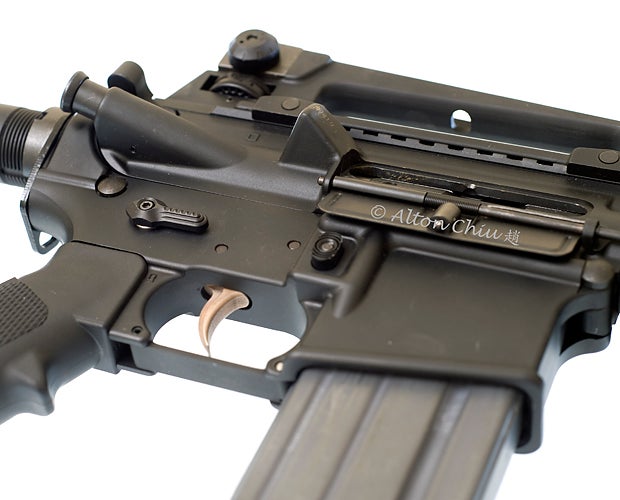Legal red tape and restrictions aside, automatic firearms have become financially challenging for the average citizen to purchase since the enactment of the Firearm Owners’ Protection Act of 1986. While transferable machine guns can cost tens of thousands of dollars, Fostech ECHO AR-II trigger provides the AR-15 family a $480 non-NFA* solution (https://fostech.us/echo-trigger.html) that fires on pull and on release.
Installation
Three major components form the ECHO trigger: the cassette containing the intricate lock work, a trigger lock, its spring, and ambidextrous selector. The user first attached the trigger lock and spring to the back of the cassette. He then held the parts in place with finger pressure while installing the assembly into the lower receiver. The trigger reused the two standard trigger pins. The provided ninety-degree throw selector featured reversible long and short levers, with the long lever pre-installed on the left side for right-handed users.
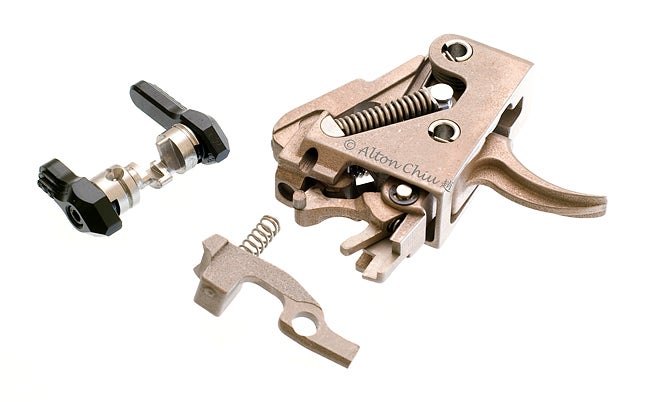
In order to close the upper receiver to the lower receiver, the user must first put the selector into echo mode. He then pushes forward on the trigger lock while pulling the trigger. This holds the lock forward so the receivers can mate. The user should take care to prevent the hammer from striking the aluminum lower receiver. The included instruction complete with illustration clearly outlined every step.
Trigger Lock
The test article is a second generation trigger that does not require a special bolt carrier to activate the trigger lock. This improved lock interfaces with a standard M16 bolt carrier to prevent premature hammer release in echo mode. Without this lock, a user shooting fast enough can release the hammer before the bolt is fully in battery. While the bottom of the bolt carrier should prevent out-of-battery firing, this is still undesirable as it creates a malfunction that must be remedied by cycling the charging handle. The trigger lock precludes this by preventing a hammer release when out-of-battery. Instead, it keeps the hammer cock and ready for the next trigger cycle.
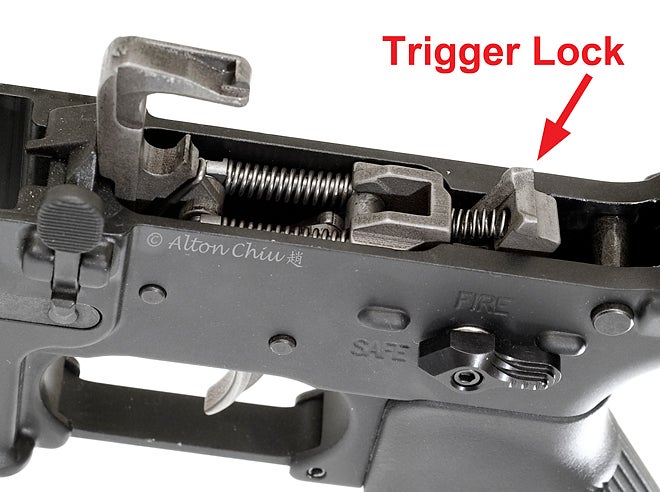
Disconnector
From the author’s observations, the Fostech trigger differentiates between semi and echo mode by splitting the traditional disconnector into two components while leaving the traditional hammer/sear interface unaltered. In semi mode, the pawl on the bolt release side (hereafter left pawl) acts like a traditional disconnector and catches the hammer while the trigger is at the rear. Control is then passed to the sear upon trigger release. In echo mode, the left pawl is moved out of the path of the hammer, while the pawl on the ejection port side (hereafter right pawl) catches the hammer. Upon release of the trigger in echo mode, the right pawl lets the hammer fall before the trigger sear can engage the hammer.
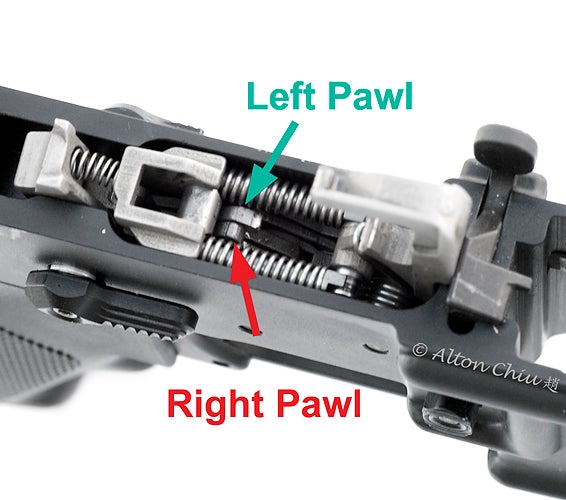
Modes of Operation
The ECHO trigger has three modes of operation: Safe, Semi, and Echo. Note that unlike a traditional AR-15 design, the user can engage the safety with the hammer decocked. Without disassembling the cassette, the author cannot verify whether the safety locks the hammer like the M1 Garand, or whether it locks the trigger like the HK G3.
In semi mode, the relatively light trigger only fires on a pull with 3mm of creep and 2mm of over-travel. Echo mode exhibits some idiosyncrasies that require mental adjustments by the user for reliable operation. Upon trigger pull, the hammer falls at the same point as in semi mode. Beyond this, the trigger has an additional 2mm of travel at a heavier pull weight. In order to have the hammer fall on release, the user must pull the trigger past the additional travel as well. When the author failed to do so, the hammer fell upon pull but not release. On the next cycle, if the author failed to pull through the additional travel, the hammer still did not fall upon pull or release. If the author pulled through the additional travel, the hammer fell only upon release. Cycling the selector reset this “memory”.
In order to reliably obtain a discharge upon pull and release, the author found himself “mashing” and “jumping-off” the trigger. This is diametrically opposed to marksmanship fundamentals where a rifleman slowly and smoothly applies pressure to the trigger in addition to holding it back through recoil. As such, the author found a mental acclimation necessary.
Shooting Test
Hammered pairs from echo mode and semi mode at seven yards were compared, with the dispersion and split times recorded. A 16inch carbine gassed AR-15 along with 75grain 5.56x45mm pressure ammunition was used for the test, as the combination generated more notable recoil in order to accentuate the dispersion. Data was gathered over five replicates of the two trigger modes with ten rounds expended each.
The dispersion data was processed such that the first impact was tared at (0, 0), while the second impact is plotted.
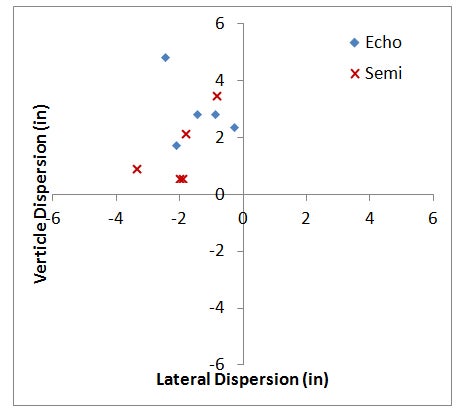
The summary statistics for the split times and dispersion magnitude are tabulated below.
|
Echo |
Semi |
|
| Split Time x̄ (sec) |
0.120 |
0.286 |
| Split Time s (sec) |
0.007 |
0.027 |
| Dispersion Magnitude x̄ (in) |
3.36 |
2.80 |
| Dispersion Magnitude s (in) |
1.20 |
0.75 |
Data Analysis
Echo mode was consistently twice as fast as semi mode, while the dispersion is not significantly different. Once the author adjusted to the idiosyncrasies of the echo mode, it very reliably produced the 0.120sec split times versus the 0.286sec of the hammered pair. This result is intuitively reasonable since echo mode discharges twice per pull-release cycle while the hammered pair only discharges once. In semi mode, the author not only experienced higher standard deviation in split times but also a number of “no-tests” as he had trouble balancing his ingrained rifle marksmanship fundamentals with the speed of a hammer pair.
The average 0.12sec split time of the echo mode fell well inside the average human reaction time of 0.28sec**. Note that the quote reaction time excludes any higher level cognitive process such as discerning a squib.This implies that, given a priori commitment, a user is likely to discharge the rifle twice, independent of other cues. The author’s semi mode split times were also close enough to the average reaction time that the same conjecture would apply.
Note that the raw extreme spread in both trigger modes were about six inches. These patterns fit just inside the torso A-zone of a USPSA target. To effectively take advantage of the echo mode split times at further distances, the user must choose a flat shooting rifle and ammunition combination.
Conclusion
The Fostech ECHO AR-II trigger provides a non-NFA simulation of a two-round burst trigger at $480. While the echo mode requires practice to reliably utilize due to its idiosyncrasies, it reduced the hammered pair split time by half while not significantly changing impact dispersion. However, these advantages are only realized at very close distances and the semiautomatic mode of the Fostech trigger has a notable amount of creep.
* https://fostech.us/media/wysiwyg/fostech/approval-letters/hawbaker-web.pdf
** https://www.humanbenchmark.com/tests/reactiontime/statistics
 Your Privacy Choices
Your Privacy Choices
